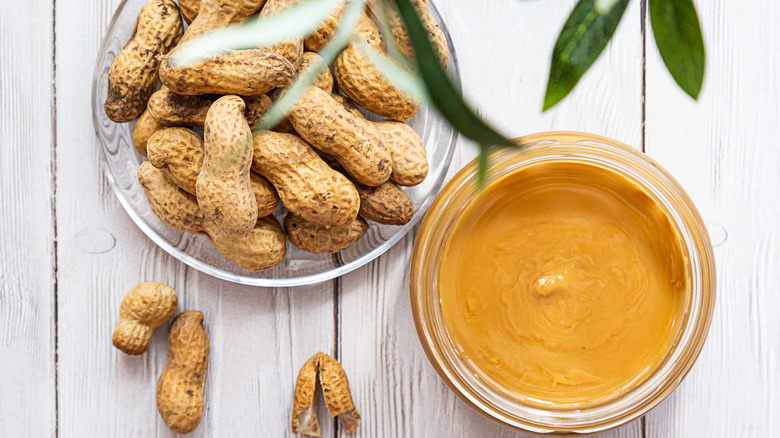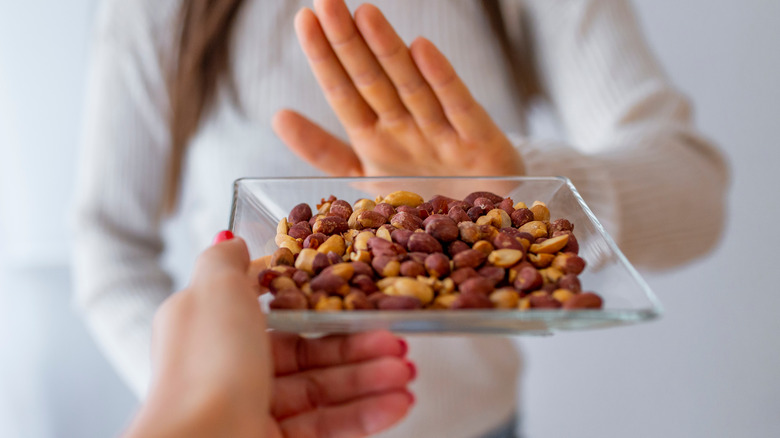This Is What Happens When You Eat Too Many Peanuts
As you may know, peanuts are loaded with fiber, protein, and healthy fats. One ounce of raw peanuts has over 7 grams of protein, according to the U.S. Department of Agriculture's Agricultural Research Service. It also provides 13.9 grams of fat and 4.5 grams of carbs, along with plenty of fiber, magnesium, calcium, and zinc. The problem is that sometimes, we eat more than just one serving, and the calories can add up quickly.
Peanuts can be a healthy addition to most diets when consumed in moderation. For example, a 2017 study published in the Journal of the American College of Cardiology found that people who ate peanuts and tree nuts at least twice a week and walnuts one or more times per week had a 13%-19% lower risk of developing heart disease, compared to their counterparts.
This crunchy snack may also reduce overall mortality risk associated with cardiovascular disease, according to a 2015 study featured in JAMA Internal Medicine. Even so, you need to watch your portion sizes and stick to 1 or 2 ounces of peanuts or 2 tablespoons of peanut butter per day (via the Peanut Institute).
We may not absorb all of the calories in nuts
If you find yourself munching on peanuts while watching TV, it's important to note that the calories can add up fast. Just 100 grams of raw peanuts contain 567 calories, according to Healthline.
On the positive side, we may not absorb all of the calories in nuts. A 2015 study published in The Journal of Nutrition suggests that some nuts, like walnuts, provide fewer calories than previously assumed. "The results show that when you can tease out the calories, or the amount of energy, actually absorbed from eating walnuts, the nut is delivering significantly fewer calories than thought," David Baer, a research physiologist with the ARS Beltsville Human Nutrition Laboratory and lead author of the study, told the U.S. Department of Agriculture. A possible explanation for this is that most people don't chew the nuts completely before swallowing them. Researchers also believe that we may not be able to fully digest nuts.
Peanuts may inhibit nutrient absorption
Some people might not know that peanuts contain lectins and phytic acid (via Chris Kresser). These "anti-nutrients" can interfere with your body's ability to absorb minerals. Additionally, they inhibit trypsin, pepsin, and other enzymes that break down food. Lectins, for example, can affect the absorption of zinc, iron, calcium, and other nutrients, according to the Harvard T.H. Chan School of Public Health. However, there is not enough evidence to confirm the adverse effects of lectins and their long-term health impact.
Functional medicine practitioner Chris Kresser explains that lectins and phytic acid are unlikely to cause any harm when consumed in small amounts. However, the Canadian Society for Intestinal Research recommends limiting your intake of phytate-rich foods if you have mineral deficiencies. In general, eating a handful of peanuts every now and then should not negatively impact your health, so long as you don't go overboard.
You may experience inflammation
Omega-6 fats, which cannot be created naturally by the body, can be found in peanuts (via SF Gate). They support brain function, hair growth, metabolism, and reproductive health. But some omega-6 essential fatty acids can trigger pain and inflammation, according to the Icahn School of Medicine at Mount Sinai. When consumed in excess, these fats promote insulin resistance, weight gain, and obesity, according to a 2016 study published in the journal Nutrients.
That being said, it's perfectly fine to swap your go-to snacks for peanuts. The key is to simply enjoy them in moderation rather than overindulging. You can also mix them with walnuts, pistachios, flaxseeds, or pumpkin seeds to get more nutrients out of your snack. Walnuts, for example, provide 4.3 grams of protein per ounce, along with a number of different minerals and nutrients, such as potassium, zinc, iron, and magnesium (via the U.S. Department of Agriculture's Agricultural Research Service).




